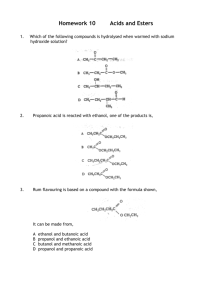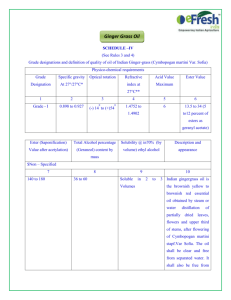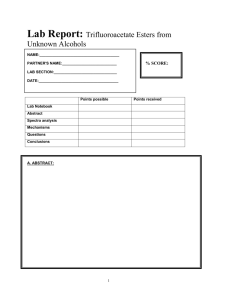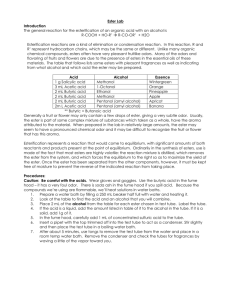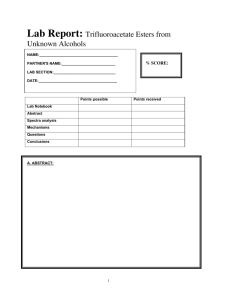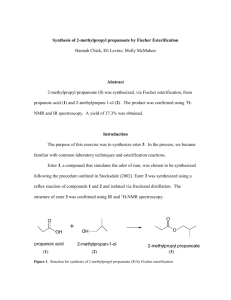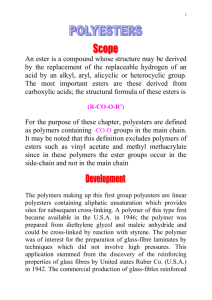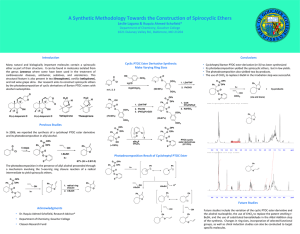Common Compounds found in Biochar by GCMS analysis
advertisement
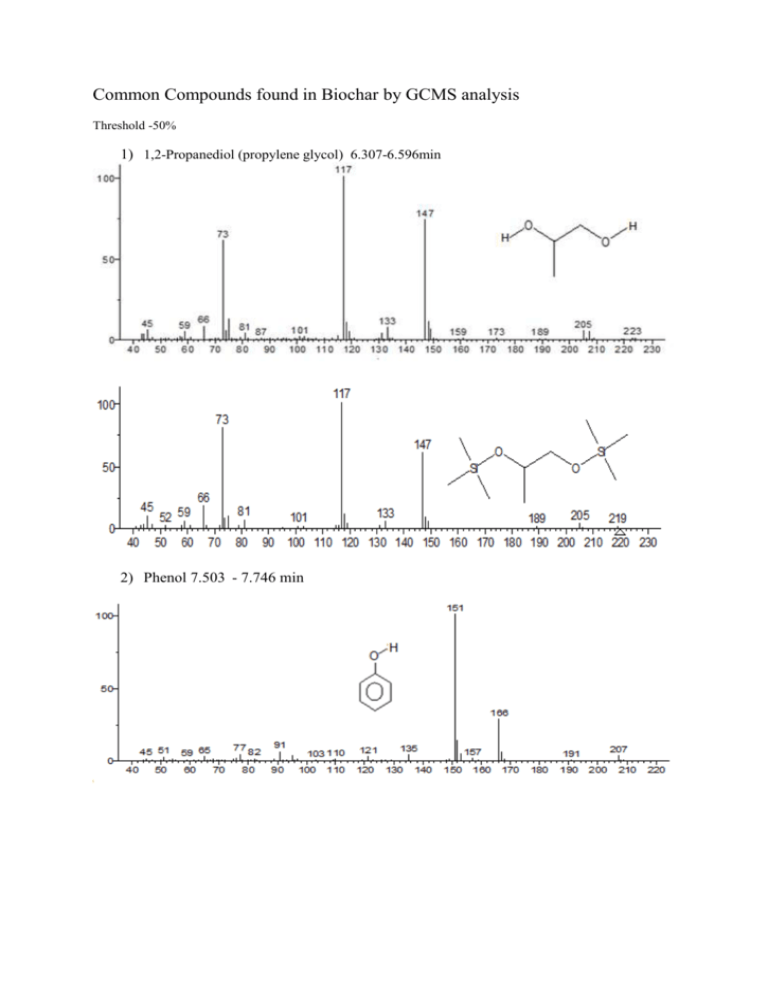
Common Compounds found in Biochar by GCMS analysis Threshold -50% 1) 1,2-Propanediol (propylene glycol) 6.307-6.596min 2) Phenol 7.503 - 7.746 min 3) Lactic Acid known as milk acid exist in muscle 4) Hexanoic Acid 7.788-8.076min 8.105-8.232min 5) Glycolic Acid is highly soluble in water. It is used in various skin-care products, and found in some sugar-crops. 8.218-8.405min 6) 1,3-Butanediol, commonly used as a solvent for food flavouring agent and is a comonomer used in certain polyurethane and polyester resins. In biology, it's used as a hypoglycaemic (low blood glucose) agent. 8.405- 8.595min 7) 2-methylphenol 9.57 -9.817min 8) 3-Methylphenol 9.817-10.124min 9) 3-Hydroxypropanoic Acid 10.124- 10.372min 10) Hydroxycarbamic acid 10.389-10.623min (Green waste sample only) 11) 3,5-Dimethylphenol 12.258-12.528min Produced at 400˚C only 12) Guaiacol ( 2-methoxyphenol )is naturally occurring, it's colourless aromatic oil, present in wood smoke, resulting from the pyrolysis of lignin. The compound contributes to the flavour of many compounds, e.g. roasted coffee. 12.276-12.554min [ (GW350 only) 13) 4-Hydroxybutanoic Acid 12.755-12.871min Naturally occurring substance found in the central nervous system. It is used as a therapeutic drug to treat insomnia, depression and alcoholism. GHB, as it is commonly known, is also used as an illegal club drug and as a date-rape drug. Read more: http://www.answers.com/topic/4-hydroxybutanoic-acid#ixzz1ad362af9 Ecalyptus600 only 14) Benzoic Acid 12.857-12.975min 15) Diethylene Glycol wildly used solvent, a hygroscopic liquid with a sweetish taste. Also used in the manufacture of unsaturated polyester resins, polyurethanes and plasticizers 12.973-3.277min 16) Octanoic Acid 13.42-13.525min 17) 2,3-Butanediol 13.682-13.913min GW550 only 18) Glycerol simple polyol compound has sweet tasting and low toxicity 13.993-14.18min 19) 2,2-dihydroxyacetic acid eluted at both RT 14.75min and 17.6min (Coconut shell and Ecalyptus 600 only) 20) 2-Methylbenzoic Acid 21) Nonanoic Acid 15.717-15.894min 15.988-16.305min 22) 2,3-Dimethoxyphenylacetic acid 16.911-17.017min 23) 2,2-dihydroxyacetic acid 17.6min same compound as 19) above 24) 3,4-Dihydroxybutanoic Acid 18.319-18.601min ( GW350 only) 25) Decanoic Acid 18.581-18.776min 26) Hexanedioic acid (Adipic acid) precursor for the production of nylon 19.985-20.121 min (Eucalyptus 600˚C only) 27) Benzaldehyde, 4-hydroxy-3-methoxy20.575-20.697min (Vanilin used as flavouring in food) 28) 2-Naphthol is used in the production of dyes and in organic synthesis, dangerous to environment. (Sucrose400˚C only) 21.19-21.349min 29) 3-Methoxycinnamic Acid 21.704-22.034min 30) Benzophenone wildly used as building block in organic chemistry, and as a photo initiator in UV-curing applications 22.82-22.96min 31) 4-Hydroxybenzoic Acid 22.876-22.959min 32) Dodecanoic Acid 33) 3,5-Dimethoxy-4-hydroxybenzaldehyde 23.384-23.602min 24.658-24.799min 34) n-Tridecanoic acid 25.667-25.701min 35) Vanillic acid (4-Hydroxy-3-methoxybenzoic acid) occur naturally in plants. It is an oxidized form of Vanillin (27). 26.069-26.243min 36) Protocatechuic acid(3,4-dihydroxybenzoic Acid) 27.384-27.562min 37) Monocaprylin 27.593-27.732min 38) 4-hydroxy-3-methoxycinnamaldehyde 27.709-27.861min (GW350˚C only) 39) Tetradecanoic Acid 27.699-27.858min 40) 2-hydroxy-2-(4-hydroxy-3-methoxyphenyl)acetic acid ( Vanilmandelic acid) 42.5% 41) Syringic acid (3,5-Dimethoxy-4-hydroxybenzoic acid) (GW350 & 450˚C only) 42) Gallic Acid(3,4,5-trihydroxybenzoic Acid) (GW350˚C only) 43) 4-Hydroxy-3,5-dimethoxycinnamaldehyde (GW350˚C only) 44) Hexdecanoic Acid 45) Heptadecanoic Acid 46) 2,4-D 2ethylhexyl ester kills a wide range of herb spp and some trees and shrubs. Doesn't kill grasses, sedges, flax or other monocots; mainly contact foliar active but has some minor root activity and moderate-low toxicity, short soil residue (Saligna 400˚C Only) ? 47) Triclopyr 2-butoxyethyl ester is one of the most common commercial products of Triclopyr which is a selective herbicide used to control woody and broadleaf plants in agriculture, forestry, parkland, roadway, and residential settings. Triclopyr is in the pyridine carboxylic acid chemical family. Exposure to triclopyr causes irregular hormone behaviour in plants, causing abnormal growth, and eventually death. (Saligna 400˚C Only) 48) Octadecanoic Acid 49) Hexanedioic Acid, bis(2-ethylhexyl)ester (Plasticizer) 50) Eicosanoic acid 51) 1,2-benzenedicarboxylic acid,dicyclohexyl ester 52) Docosanoic Acid ( Sucrose700˚C) 53) Sucrose 54) Tricosanoic Acid 55) 2-Heptacosanone 56) Octacosanol 57) Cholesterol

